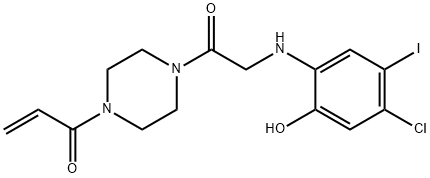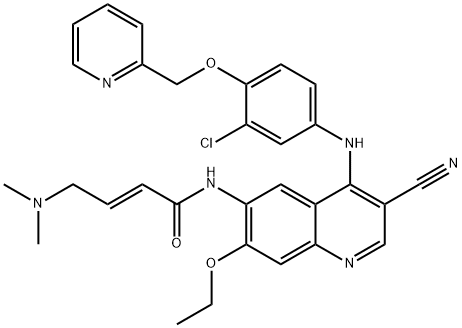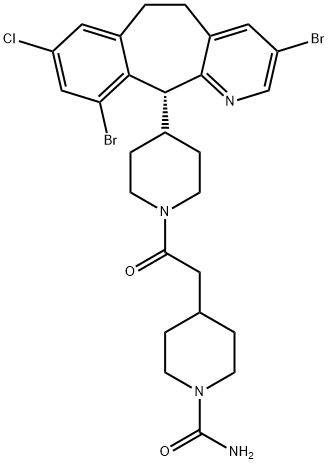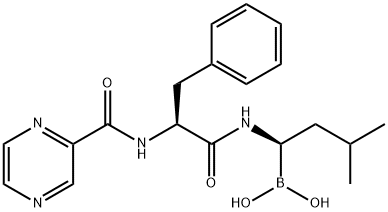K-Ras(G12C) inhibitor 9
- CAS NO.:1469337-91-4
- Empirical Formula: C16H21ClIN3O4S
- Molecular Weight: 513.78
- MDL number: MFCD28143916
- SAFETY DATA SHEET (SDS)
- Update Date: 2024-11-19 23:02:33

What is K-Ras(G12C) inhibitor 9?
Description
K-Ras(G12C) inhibitor 9 is an irreversible, allosteric inhibitor of the K-Ras(G12C) mutant that causes 100% modification of the protein when used at 10 μM for 24 hours in vitro. K-Ras is a small GTPase that cycles between a GTP-bound active state and a GDP-bound inactive state to turn on downstream Raf kinases to drive cell growth. A G12C mutation in K-Ras blocks GTP hydrolysis, activates K-Ras, and promotes carcinogenesis. Similar K-Ras(G12C) inhibitors significantly reduce GTP affinity relative to GDP, decrease Raf binding, and lower cell viability while increasing apoptosis.
The Uses of K-Ras(G12C) inhibitor 9
N-[1-[2-[(4-Chloro-5-iodo-2-methoxyphenyl)amino]acetyl]-4-piperidinyl]ethenesulfonamide is an allosteric inhibitor of tumor-promoting K-Ras(G12c).
in vitro
k-ras(g12c) inhibitor 9 belongs to a series of small molecules, which irreversibly compete with gtp and gdp for binding to a common oncogenic k-ras(g12c) mutant and blocked the association of b-raf and c-raf with k-ras(g12c). k-ras(g12c) inhibitor 9 (10 μm) decreased viability and increased apoptosis of g12c mutations-containing lung cancer cell lines (h1792, calu-1, h358, and h23) [1].
References
1. ostrem jm, peters u, sos ml, wells ja, shokat km. k-ras(g12c) inhibitors allosterically control gtp affinity and effector interactions. nature. 2013;503(7477):548-51. 2. hunter jc, gurbani d, ficarro sb, carrasco ma, lim sm, choi hg, et al. in situ selectivity profiling and crystal structure of sml-8-73-1, an active site inhibitor of oncogenic k-ras g12c. proc natl acad sci u s a. 2014;111(24):8895-900. 3. lim sm, westover kd, ficarro sb, harrison ra, choi hg, pacold me, et al. therapeutic targeting of oncogenic k-ras by a covalent catalytic site inhibitor. angew chem int ed engl. 2014;53(1):199-204.
Properties of K-Ras(G12C) inhibitor 9
| Boiling point: | 656.3±65.0 °C(Predicted) |
| Density | 1.68±0.1 g/cm3(Predicted) |
| storage temp. | Store at -20°C |
| solubility | Soluble in DMSO |
| form | crystalline solid |
| pka | 9.68±0.20(Predicted) |
| color | White to off-white |
Safety information for K-Ras(G12C) inhibitor 9
| Signal word | Warning |
| Pictogram(s) |
 Exclamation Mark Irritant GHS07 |
| GHS Hazard Statements |
H302:Acute toxicity,oral H315:Skin corrosion/irritation H319:Serious eye damage/eye irritation H335:Specific target organ toxicity, single exposure;Respiratory tract irritation |
| Precautionary Statement Codes |
P261:Avoid breathing dust/fume/gas/mist/vapours/spray. P305+P351+P338:IF IN EYES: Rinse cautiously with water for several minutes. Remove contact lenses, if present and easy to do. Continuerinsing. |
Computed Descriptors for K-Ras(G12C) inhibitor 9
New Products
4-AMINO-TETRAHYDRO-PYRAN-4-CARBOXYLIC ACID HCL 4-(Dimethylamino)tetrahydro-2H-pyran-4-carbonitrile 4-Aminotetrahydropyran-4-carbonitrile Hydrochloride (R)-3-Aminobutanenitrile Hydrochloride 3-((Dimethylamino)methyl)-5-methylhexan-2-one oxalate 1,4-Dioxa-8-azaspiro[4.5]decane 5-Bromo-2-nitropyridine Nimesulide BP Aceclofenac IP/BP/EP Diclofenac Sodium IP/BP/EP/USP Mefenamic Acid IP/BP/EP/USP Ornidazole IP Diclofenac Potassium THOMAIND PAPER PH 2.0 TO 4.5 1 BOX BUFFER CAPSULE PH 9.2 - 10 CAP SODIUM CHLORIDE 0.1N CVS ALLOXAN MONOHYDRATE 98% PLATINUM 0.5% ON 3 MM ALUMINA PELLETS (TYPE 73) LITHIUM AAS SOLUTION 2-Bromo-1-(bromomethyl)-3-chloro-5-nitrobenzene 2-Bromo-3-nitroaniline N-(3-Hydroxypropyl)-N-methylacetamide 3-Bromo-6-chloropyridazine 4-ethyl-3-nitrobenzoic acidRelated products of tetrahydrofuran








You may like
-
 1-Methyl-6-oxo-1,6-dihydropyridazine-3-carbonitrile 98%View Details
1-Methyl-6-oxo-1,6-dihydropyridazine-3-carbonitrile 98%View Details
99903-60-3 -
 88491-46-7 98%View Details
88491-46-7 98%View Details
88491-46-7 -
 1823368-42-8 98%View Details
1823368-42-8 98%View Details
1823368-42-8 -
 2-(3-(tert-butyl)phenoxy)-2-methylpropanoic acid 1307449-08-6 98%View Details
2-(3-(tert-butyl)phenoxy)-2-methylpropanoic acid 1307449-08-6 98%View Details
1307449-08-6 -
 Ethyl 3-(furan-2-yl)-3-hydroxypropanoate 25408-95-1 98%View Details
Ethyl 3-(furan-2-yl)-3-hydroxypropanoate 25408-95-1 98%View Details
25408-95-1 -
 2-Chloro-5-fluoro-1-methoxy-3-methylbenzene 98%View Details
2-Chloro-5-fluoro-1-methoxy-3-methylbenzene 98%View Details
1805639-70-6 -
 1784294-80-9 98%View Details
1784294-80-9 98%View Details
1784294-80-9 -
 Lithium ClavulanateView Details
Lithium ClavulanateView Details
61177-44-4